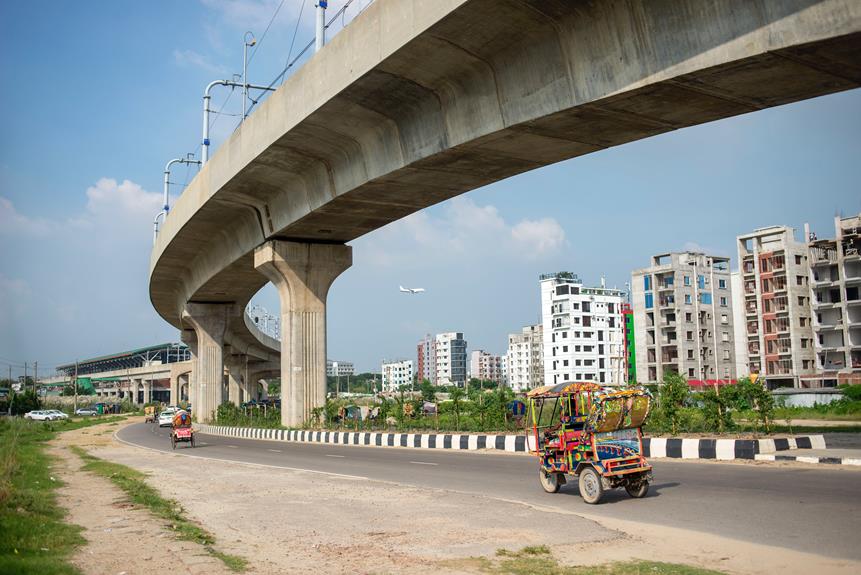Natore District, situated in Bangladesh, holds a remarkable position as a historical battleground and thriving agricultural hub. Its significance as a site of fierce battles during the liberation war in 1971 has left an indelible mark on the region's history. However, Natore's importance extends far beyond its past conflicts. With its fertile lands and a strong economy centered around farming and sugar production, this district has become an agricultural powerhouse. Furthermore, its strategic location and diverse demographic makeup make Natore a captivating region to explore. In this article, we will uncover the captivating historical background and the flourishing agricultural landscape of Natore District.
Historical Significance
Natore District holds immense historical significance due to its role as a battleground during the Liberation War of Bangladesh in 1971 and its rich historical heritage dating back to the British colonial era. The district witnessed intense fighting between the Pakistani army and the freedom fighters of Mukti Bahini, resulting in the sacrifice of many brave individuals. These battles played a crucial role in the country's struggle for independence. Today, Natore District stands as a symbol of the indomitable spirit of the Bangladeshi people. Efforts have been made to preserve and commemorate the historical events that took place in the district. Monuments, memorials, and museums have been established to honor the heroes and educate future generations about the sacrifices made for freedom. These preservation efforts ensure that the historical significance of Natore District's role in the country's independence is not forgotten.
Geographical Features
The district of Natore boasts a diverse range of geographical features that contribute to its significance and appeal. One of the prominent features is the Chalan Beel ecosystem, which is the largest beel in Bangladesh and is located within the district. The beel plays a vital role in the region's ecology, supporting a rich biodiversity of flora and fauna. Natore District covers an area of 1,900.05 square kilometers and is bordered by Naogaon, Bogra, Pabna, Kushtia, Sirajganj, and Rajshahi districts. This strategic location enhances the district's connectivity and accessibility. In terms of natural resources, Natore is known for its agricultural productivity, with a strong emphasis on rice cultivation. The fertile plains and favorable climatic conditions contribute to the district's agricultural success.
Battle of 1971
Amidst Natore District's rich geographical features and agricultural prowess, a significant event unfolded in 1971 that left an indelible mark on its history: the Battle of 1971. This battle was fought between the Pakistani army and the freedom fighters of Mukti Bahini, the Bangladesh Liberation Force. Here are some key facts about this historic battle:
- Intense fighting: The Battle of 1971 witnessed fierce clashes between the Pakistani army and Mukti Bahini, as both sides fought for control over Natore District.
- Casualties: Approximately 40 members of the Pakistani army lost their lives during the battle, highlighting the determination and bravery of Mukti Bahini in their fight for liberation.
- Strategic importance: Natore District held significant strategic importance due to its geographical location, making it a crucial battleground in the war for Bangladesh's independence.
- Symbol of resistance: The Battle of 1971 in Natore District stands as a symbol of the heroic resistance put up by the freedom fighters against the oppressive Pakistani regime, ultimately leading to the birth of an independent Bangladesh.
Etymology and Municipal Development
Establishing its roots in the year 1845, Natore Mahakuma ignited the path towards municipal development in the district. The name "Natore" is believed to have derived from two words – "Nath" meaning lord or god, and "Ore" meaning land or place. This suggests that Natore was once considered a sacred land. Over the years, the municipality has evolved to become an important administrative and commercial center. In 1869, Natore Municipality was established, marking a significant milestone in the municipal development of the district. Today, Natore Municipality plays a crucial role in providing essential services such as waste management, infrastructure development, and maintaining law and order. The town continues to grow, attracting businesses and residents due to its strategic location and historical significance.
Agricultural Economy
A significant aspect of Natore District's economy is its thriving agricultural sector. The district is known for its rich agricultural practices and crop diversity. Here are four key points about the agricultural economy in Natore:
- Crop Diversity: Natore District boasts a wide range of crops, including rice, wheat, jute, sugarcane, vegetables, and fruits. This crop diversity not only contributes to the local economy but also ensures food security for the region.
- High Yielding Varieties: Farmers in Natore have embraced modern agricultural techniques and are using high-yielding varieties of seeds, fertilizers, and pesticides. This has led to increased productivity and improved crop quality.
- Irrigation Facilities: The district benefits from ample water resources, including the mighty Padma River and the Chalan Beel wetland. Irrigation facilities, such as canals and tube wells, play a crucial role in supporting agricultural activities and mitigating the effects of drought.
- Agricultural Support Services: The district administration, along with various government and non-government organizations, provides farmers with training programs, agricultural loans, and technical assistance. These support services help farmers adopt best practices and enhance their productivity.
Industrial Growth
Natore District's robust agricultural economy has paved the way for significant industrial growth in the region, contributing to its overall economic development. The district is home to several key industries that have played a crucial role in its industrial development. Notably, Natore houses two sugar mills, namely North Bengal Sugar Mills Limited and Natore Sugar Mills Limited. These mills have not only provided employment opportunities but have also contributed to the local economy through the production of sugar and other related products. Additionally, Natore is also home to Pran Agro Ltd., a private food manufacturing plant, and Jamuna Distillery Limited, which produces industrial alcohol. These industries have had a positive economic impact on the district, promoting growth, generating revenue, and creating job opportunities for the local population.
Demographic Profile
The demographic profile of Natore District showcases a population that is primarily composed of Muslims, accounting for 93.22% of the total population, while Hindus make up 6.08% of the district's inhabitants. The district has a population distribution where 22.4% of the population resides in urban areas, indicating a primarily rural population. The population density in Natore is 979 people per square kilometer, suggesting a moderately dense population. The literacy rate among individuals aged 7 and over is 71.4%, indicating a significant portion of the population has attained basic education. These demographic factors provide insights into the religious composition, urban-rural distribution, and educational attainment of the people in Natore District. Such information is crucial for understanding the social fabric and development needs of the district.
Cultural Heritage
Having explored the demographic profile of Natore District, it is now essential to delve into its rich cultural heritage. Natore is known for its cultural preservation and vibrant traditional festivals that showcase the district's deep-rooted traditions and customs. The table below highlights some of the prominent cultural aspects of Natore District:
| Cultural Heritage | Traditional Festivals |
|---|---|
| Folk music and dance | Rash Mela |
| Traditional handicrafts | Durga Puja |
| Local cuisine | Pahela Baishakh celebration |
| Historical landmarks | Nobanno Utsab |
| Religious diversity | Kali Puja |
Natore District takes great pride in preserving its cultural heritage, and the traditional festivals attract locals and tourists alike. The Rash Mela, a festival dedicated to Lord Krishna, is celebrated with joy and enthusiasm. The district also showcases its traditional handicrafts, including pottery, weaving, and woodwork. Food lovers can indulge in the distinct flavors of Natore's local cuisine, which includes delicacies like Shorshe Ilish (Hilsa fish in mustard sauce) and Pitha (traditional rice cakes). The district's historical landmarks, such as the Natore Rajbari and Uttara Gano Bhaban, provide glimpses into its glorious past. With its religious diversity, Natore celebrates festivals like Durga Puja, Pahela Baishakh, and Kali Puja, bringing people together in a spirit of unity and harmony.
Frequently Asked Questions
What Is the Significance of Natore District in the History of Bangladesh?
The significance of Natore District in Bangladeshi history lies in its role as a historical battleground and agricultural hub. During the Battle of 1971, the district witnessed fierce fighting between the Pakistani army and the freedom fighters of Mukti Bahini. This battle resulted in the loss of around 40 Pakistani soldiers. Additionally, Natore District is known for its agricultural economy, with major industries such as sugar mills and food manufacturing plants contributing to its economic development.
What Are the Major Geographical Features of Natore District?
Natore District, located in Bangladesh, has several major geographical features. It is primarily a plain land area, with the notable inclusion of Chalan Beel, the largest beel (wetland) in the country. The district shares borders with Naogaon, Bogra, Pabna, Kushtia, and Sirajganj districts. Natore District covers an area of 1,900.05 square kilometers and is situated approximately 220 kilometers away from Dhaka. These geographical characteristics contribute to the significance of Natore District in Bangladesh's history and its role as an agricultural hub.
Can You Provide More Details About the Battle of 1971 That Took Place in Natore District?
The Battle of 1971 in Natore District holds significant historical importance. It was a crucial conflict between the Pakistani army and the freedom fighters of Mukti Bahini during the Bangladesh Liberation War. The battle resulted in the death of approximately 40 Pakistani army members. In addition, on May 5, 1971, 42 employees of North Bengal Sugar Mills were killed by the Pakistani army. These events highlight the bravery and sacrifice of the people of Natore in their fight for independence.
How Did Natore District Get Its Name? Can You Explain Its Etymology?
Natore district derives its name from the word "Nator," which means "human settlement" in the local dialect. The significance of Natore in the history of Bangladesh lies in its role as a historical battleground and agricultural hub. It served as the district headquarters of Rajshahi in the past and witnessed several important events, including the battle between the Pakistani army and the freedom fighters of Mukti Bahini in 1971. Natore's rich agricultural economy, with its sugar mills and food manufacturing plants, contributes to its importance in the region.
What Are Some Notable Municipal Developments in Natore District and How Have They Contributed to Its Growth and Development?
Some notable municipal developments in Natore District include the establishment of Natore Mahakuma in 1845 and the Natore Municipality in 1869. These developments have contributed to the growth and development of the district by providing administrative and governance structures. Additionally, the presence of industries such as the North Bengal Sugar Mills Limited, Natore Sugar Mills Limited, Pran Agro Ltd., and Jamuna Distillery Limited has further stimulated economic growth in the district. These municipal developments have played a crucial role in shaping the infrastructure and economy of Natore District.





